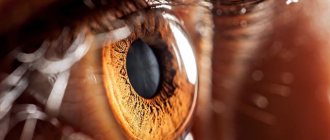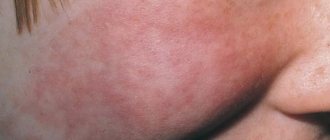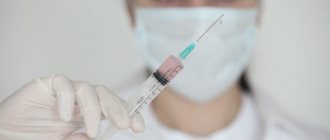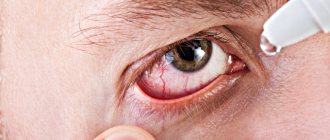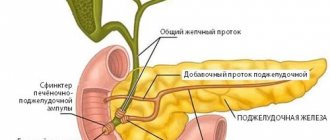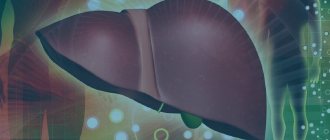Obstructive jaundice develops when the flow of bile from the gallbladder into the duodenum is impaired. This condition is not an independent disease. Obstructive jaundice is a symptom that is characteristic of many diseases of the abdominal organs. Due to its fairly high prevalence, doctors of different specialties often have to deal with this problem and prescribe different types of treatment to patients.
- Options for the development of obstructive jaundice
- Principles of treatment of obstructive jaundice
- Consequences and prognosis for obstructive jaundice
- Prevention methods
Screening
Multifactorial analysis of clinical, laboratory and instrumental data allowed us to identify several indicators that allow us to reasonably suspect the presence of choledocholithiasis and continue to search for it using invasive research methods. These include dilation of the extrahepatic bile ducts (more than 8 mm) according to ultrasound, clinical signs of cholangitis, increased levels of aminotransferases and direct fraction of bilirubin in the blood serum, small stones in the gall bladder (less than 5 mm). It is also recommended to evaluate anamnestic data (the presence of episodes of jaundice, exacerbations of chronic cholecystitis or pancreatitis).
Why is it necessary to consult a doctor at the first symptoms?
Pain and other signs of illness in the liver area cannot be ignored, especially if there have already been operations in the anamnesis. By self-medicating, we only remove symptoms and waste time. So, in the case of tumors, at an early stage they can be removed and treated. Stones blocking the gap increase in size over time and become more difficult to remove. Timely detection of the cause is 50% of successful treatment.
If the skin and sclera turn yellow, emergency medical attention is needed. Failure to see a doctor promptly can lead to death.
Classification
Causes of obstruction of the biliary tract:
- Benign diseases (80%): - choledocholithiasis; - cholangitis; - stenosis of the major duodenal papilla; - acute papillitis; - polyps of the large duodenal papilla; - pancreatitis; — cicatricial stricture of the main bile ducts; - peripapillary diverticula; - rare causes (congenital anomalies of the bile ducts, pericholedocheal lymphadenitis, parasitic lesions, etc.).
- Malignant neoplasms (20%): - pancreas; - large duodenal papilla; - bile ducts; - liver (primary or metastatic lesion).
The nature of the course of jaundice:
- full,
- incomplete,
- intermittent.
Severity of liver failure:
- light,
- average,
- heavy.
Etiology
Obstruction of the bile ducts, leading to obstructive jaundice, can occur against the background of benign diseases (in 80% of cases) and some malignant neoplasms (20%). The most common cause of obstructive jaundice is choledocholithiasis, less often - “benign” jaundice, which can be caused by stenosis of the large duodenal papilla, its polyps and papillitis, cholangitis, acute and chronic pancreatitis, cicatricial stricture of the bile ducts, parapapillary diverticula of the duodenum and other rare causes ( congenital anomalies of the bile ducts, pericholedocheal lymphadenitis, parasitic lesions, etc.). “Malignant” obstructive jaundice can occur with cancer of the head of the pancreas, large duodenal papilla, bile ducts, primary or metastatic liver cancer.
Intraoperative methods
For the most part, constructive intervention in the treatment of obstructive jaundice ends with the formation of an opening for the drainage of bile into the gastrointestinal tract or drainage of the ducts. As a rule, the gallbladder is combined with the small intestine. It is worth noting that experts prefer minimally invasive methods for eliminating obstructive jaundice if the disease is accompanied by oncology. The choice of one or another method of operation, which guarantees the best result, is of a purely individual nature.
Pathogenesis
Under physiological conditions, the liver secretes up to 250 mg of the bile pigment bilirubin into the bile during the day. It is formed in the cells of the reticuloendothelial system from the released hemoglobin of mature red blood cells. The scheme of biochemical transformations of bilirubin is presented in Fig. . Biochemical transformations of bilirubin (scheme). When the level of bilirubin in the blood serum increases to more than 40 µmol/l, the sclera, mucous membranes and skin become icteric. Bilirubin penetrates almost all fluids and white parts of the body tissues, causing yellow coloration of exudates and transudates, secretions of various glands (pancreas, salivary, sweat, etc.). In patients with anemia and fair skin, jaundice is detected earlier, while in dark-skinned patients it goes undetected longer. Obstructive jaundice syndrome should be considered as a complex pathophysiological complex, manifested by signs of damage to all organs and systems, mainly the liver and kidneys. With obstruction of the biliary tract, as the duration and intensity of jaundice increases, all homeostasis systems undergo increasing pathological changes. In extrahepatic cholestasis, direct bilirubin returns to the blood and lymph from the small intrahepatic bile ducts. As cholestasis progresses, a change in the polarity of hepatocytes occurs, as a result of which the complex of bilirubin with glucuronic acid begins to be excreted through the blood vessels, which leads to an increase in the content of direct bilirubin in the blood. As pressure increases in the bile capillaries, microcirculation and blood supply to liver cells are disrupted, and the membranes of the bile ducts and hepatocytes are damaged. Thus, there is a progressive disruption of the synthetic and metabolic functions of the liver and, as a consequence, the composition of the plasma and the rheological properties of the blood. The severity of clinical manifestations in patients with obstructive jaundice is determined by profound disorders of the liver, kidneys, cardiovascular and nervous systems, as well as disorders of the blood coagulation system and metabolism. Jaundice is a leading symptom only in the initial stages of the disease, reflecting the resulting disturbances in the outflow of the biliary tract. As the intensity of jaundice increases and its duration increases, functional and morphological changes in all body systems gradually intensify. At a certain stage of development, jaundice ceases to be only a symptom; it becomes an independent leading factor, which has its own pathophysiological and clinical characteristics and determines the severity of the patient’s condition and the prognosis of the disease. The duration of obstructive jaundice and its intensity largely determine the development of liver failure and deaths (including postoperative ones). The accumulation of toxic metabolic products in the blood serum (bilirubin, bile acids, ammonia, etc.) leads to endotoxemia, the severity of which is associated with the duration of the disease, therefore early diagnosis of the cause of jaundice and decompression of the bile ducts largely determine the outcome of the disease.
Symptoms of obstructive jaundice
Even before yellowing appears, the patient begins to experience pain in the right hypochondrium. Depending on the cause, the sensations may vary in intensity and frequency. Normally, bile is released from the bladder into the ducts when the gallbladder contracts when the food mass reaches the duodenum. Therefore, at the beginning of the disease, pain is felt mainly after eating, and may disappear completely or subside before a new attack. And when bile accumulates, pressure on the walls of the ducts and bladder increases, and constant severe debilitating pain appears. Most often encircling or radiating to the area of the shoulder blades.
Feces become colorless and greasy, since without bile fats are not digested and there is no coloring pigment.
The urine is dark as a result of pigment being excreted by the kidneys.
If there is inflammation, the temperature rises, chills and weakness appear.
Bile components that enter the bloodstream poison the body and lead to itchy skin, blood clotting disorders, and decreased blood pressure and heart rate (bradycardia). The patient is anxious, panics, sleeps poorly.
When the duct is not completely blocked, the symptoms are less pronounced.
Clinical picture
Clinical symptoms that are considered typical manifestations of jaundice are presented in Fig. 45-2. The clinical picture depends on the severity, duration and nature of jaundice.
Clinical manifestations of obstructive jaundice. Obstructive jaundice, caused by choledocholithiasis (up to 80% of cases), appears several hours or days after a severe attack of pain in the abdomen. Characterized by rapid progression. The development of jaundice is accompanied by skin itching. Scratching occurs predominantly on the anterior abdominal wall and extensor surfaces of the limbs. Patients pay attention to darkening of urine and the appearance of discolored feces. Obstructive jaundice caused by a tumor of the head of the pancreas or the major duodenal papilla is characterized by the absence of pain and the gradual development of the disease. Courvoisier syndrome is considered pathognomonic, which manifests itself as a palpable enlarged, painless gallbladder against the background of jaundice.
Diet
To get the maximum effect from the operation and not provoke a relapse, the patient must follow a diet before and after the intervention. It is also important to maintain a drinking regime: at least 2 liters of clean water are recommended per day. This rule allows you to quickly remove toxic bilirubin from the body and reduce its effect on other organs.
The diet includes:
- sweetened tea, compote, diluted glucose solution;
- vegetable soups;
- viscous porridge with milk;
- low-fat varieties of fish and meat, steamed or boiled;
- You can gradually introduce white bread (day-old or fresh dried), and butter in small quantities.
All dishes must be served at room temperature.
Diagnostics
The diagnostic search for obstructive jaundice consists of confirming its obstructive nature and determining the immediate cause of obstruction of the biliary tract. At the outpatient stage, up to 20% of diagnostic errors occur, leading to hospitalization of patients in non-core medical institutions. Patients with obstructive jaundice are often initially hospitalized in infectious diseases departments; somewhat less often, patients with hepatitis of various natures or other types of jaundice of non-surgical origin are admitted to surgical hospitals. In both cases, erroneous hospitalization has negative consequences associated with the choice of incorrect management tactics, violations of the anti-epidemic regime, delays in performing bile duct decompression, etc.
Endoscopic technique
Drainage with a catheter helps restore the outflow of bile. The catheter looks like a polyethylene tube with holes at the end. As a rule, this type of drainage does not cause complications and can be inserted for 1-2 weeks.
The main disadvantages are the difficulty of installing the device, the lack of catheterization in case of damage to the intrahepatic ducts, as well as mandatory daily monitoring. If the tumor has affected the extrahepatic ducts, and radical intervention is contraindicated, the patient undergoes stenting. This process involves the installation of an elastic tube that will support the bile duct. The stent allows free passage of bile from the liver.
Stenting is performed after the inflammation has passed. Stents can maintain patency for several months (metal stents take a little longer). After 6 months it must be replaced. The main disadvantages of plastic stents include the possibility of migration into the intestine and clogging of the lumen with bile.

